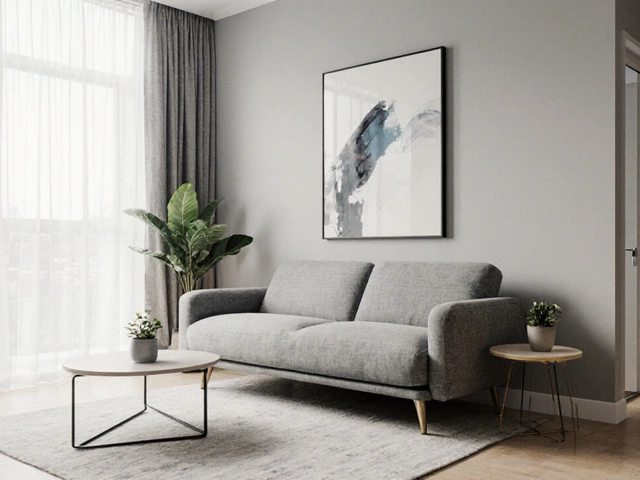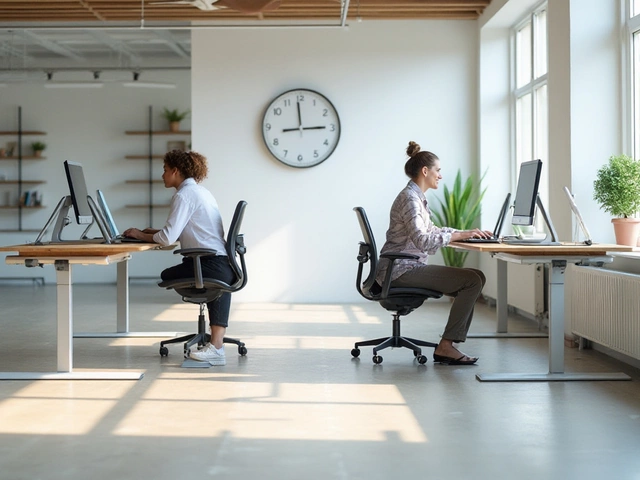
Picking the right wood thickness for a coffee table isn’t just about style. Too thin and you end up with a wobbly table that might bow or break with heavy use. Too thick and your table can look bulky and cost way more than it should. There’s a sweet spot that hits the mark for both looks and durability.
Most folks who build or buy coffee tables wonder if that extra half-inch really makes a difference. The short answer? It can. The wood's thickness decides how stable the table feels, how much weight it holds, and even whether the top will warp over time. Cut corners here, and you’ll probably regret it—cracked or saggy tables aren’t fun for anyone.
- Why Wood Thickness Matters for Coffee Tables
- Standard and Recommended Thicknesses
- What Influences Your Choice
- Practical Tips for Building or Buying
Why Wood Thickness Matters for Coffee Tables
If you care about your coffee table actually lasting more than a few months, wood thickness is a big deal. The thickness of the tabletop and legs directly affects how strong and stable your table will be. Put a heavy stack of books or plop your feet on a table with a flimsy top, and you’re asking for trouble—bending, sagging, or even breaking can happen if the wood is too thin.
Think about the usual use: cups, plates, game boards, maybe a restless cat or an overexcited toddler. All that adds weight and pressure across the table. Thicker wood handles that load better and spreads out the force so you don’t end up with dents or warping. Tables with tops under 3/4 inch thick are known to flex and even split over time, especially if you use soft pine or lower-grade materials.
If resale or looks matter to you, thick wood gives that solid, high-end appearance people want. Ever notice how high-quality stores never sell tables with tops thinner than an inch? There’s a reason: thicker tops just feel sturdier and more expensive, while thin ones shout “budget.”
Some people think using thinner wood saves money, but in reality, wobbly or sunken tables end up costing more in repairs—or replacements. The best part? If you pick the right thickness upfront, you barely have to worry about issues for years.
| Wood Thickness | Performance/Result |
|---|---|
| 1/2 inch | Prone to sagging, not recommended |
| 3/4 inch | OK for small tables, may flex |
| 1 inch | Standard, sturdy for most uses |
| 1.5 inches | Extra strong, premium feel |
In short, if you want a wood coffee table that doesn’t wobble, warp, or crack under pressure, don’t skimp on thickness. Think long-term—your future self (and your living room) will thank you.
Standard and Recommended Thicknesses
If you’re aiming for a solid, reliable coffee table, the most popular wood thickness for the top is between 3/4 inch (about 19mm) and 1 1/2 inches (about 38mm). This range strikes the best balance between strength and looks. Most big-name furniture stores sell tables right in this range, and there’s a reason—they tend to last longer and handle daily wear without much fuss.
Let’s get specific. Here’s a quick list of what actually works for home use:
- 3/4 inch (19mm): A good starting point for lighter tables or those with strong under-support. It’s common for MDF or plywood-topped tables, but it’s best to reinforce underneath to stop sagging if you’re using real wood over larger spans.
- 1 inch (25mm): The go-to for a sturdy woodworking project. At an inch, solid hard woods like oak or maple feel secure and look polished. This is also a sweet spot for people who want a table that stands up to bumps and kids climbing on top.
- 1 1/4 to 1 1/2 inch (32-38mm): Great for chunkier designs or if you want that ultra-premium, solid feel. You’ll see this thickness a lot with rustic or farmhouse-style tables. It costs more, but you probably won’t worry about warping—at all.
The table below shows how different wood thicknesses perform for regular coffee tables, so you can easily compare your options:
| Thickness | Best For | Notes |
|---|---|---|
| 3/4 inch | Small to medium tables, reinforced | Needs extra support to avoid sagging |
| 1 inch | Most tables, standard look | Solid choice for most homes |
| 1 1/4 in+ | Large, statement tables | Heavy, very sturdy, higher cost |
Don’t forget—if you’re planning a big table or want to use softer wood like pine, thicker is better. Thinner tops are fine for smaller tables or when metal frames carry the load. If you’re using reclaimed or live-edge wood, always measure the thinnest part. That weak spot decides if your table stability will hold up.

What Influences Your Choice
There’s no one-size-fits-all answer when it comes to how thick wood should be for a coffee table. Several real-life factors will shape your decision, and they’re not just about how the table looks. You want it to last, stay stable, and not bust your budget.
Wood species comes first. Some woods, like oak and maple, are naturally tough. Pine, on the other hand, is softer and can ding up faster if it’s too thin. If you’re using a hard wood, you can get away with thinner boards—usually around 3/4 inch (19mm) for the top. With softer woods, you may need to bump that up to an inch (25mm) or more just to keep things sturdy.
The size of the coffee table matters, too. Longer and bigger tables need thicker tops to stay flat under weight. For a standard living room size (about 48 inches long), most people stick to wood between 3/4 inch and 1 1/4 inches thick. Oversized tables, though, may need tops as thick as 1 1/2 inches to keep from bowing.
How you plan to use the table is a biggie. Got little kids who use every surface as a jungle gym? Hosting friends who love piling up board games, drinks, and snacks? Go thicker for more strength. If it’s mostly for show or light use, you can keep the thickness down and maybe save some cash.
Let’s not ignore budget. Thicker slabs of good-quality wood are pricier—sometimes a lot pricier. That’s why engineered wood (like plywood over a solid frame) is pretty popular. It can look great and hold up well without the full cost of chunky solid wood.
- Joinery choices—Edge-glued boards or solid slab? Edge-glued is stronger and resists warping.
- Base design—Hairpin legs, chunky blocks, or a central pedestal all put pressure on the tabletop in different ways. Flimsier legs? Thicker top. Solid, wide legs? You don’t need crazy thickness up top.
- Style—Modern, minimal tables sometimes use thicker tops for that “chunky” vibe, while mid-century or vintage styles often go slimmer.
A quick snapshot of how these factors stack up:
| Factor | Typical Thickness |
|---|---|
| Softwood, small table | 1 inch (25mm) |
| Hardwood, medium table | 3/4 to 1 inch (19-25mm) |
| Large/long table | 1 1/4 inch (32mm) or more |
| High use / heavy items | 1 1/4 inch+ (32mm+) |
| Budget option, engineered wood | 1 inch (25mm), layered or veneered |
The sweet spot really depends on your living room, your daily routine, and your wallet. Just weighing these details up front means you get a coffee table that lasts and actually works for the way you live.
Practical Tips for Building or Buying
Let’s make this simple. If you want your coffee table to last, keep these tips in mind whether you’re building it yourself or shopping for one.
- Solid hardwoods (like oak, maple, or walnut) should be at least 3/4 inch (about 19 mm) thick for the tabletop. This thickness handles everyday knocks and keeps the surface from sagging—even if your table ends up loaded with stuff now and then.
- If you’re using plywood or engineered wood, go for at least 1 inch (25 mm) thickness. These materials aren’t quite as stiff as real hardwood, so a bit more thickness helps with stability.
- Watch the legs, too. They’re doing the real heavy lifting. Table legs made from solid wood are typically 1 1/2 to 2 inches square (about 38–50 mm), which keeps your furniture from wobbling.
- For a modern, lightweight look, you might see thinner tops (around 5/8 inch, or 16 mm), but these almost always need added support underneath to avoid flexing or warping.
- If your table is extra long—over 4 feet—a thicker top (1 inch or more) keeps everything sturdy. For shorter, smaller tables, you can sometimes get away with a little less.
Worried about weight? Standard wood thickness adds some heft, but even a 3/4 inch oak top on a typical 48" x 24" table weighs less than 40 pounds, which is manageable for most rooms.
| Wood Type | Recommended Thickness | Common Table Size |
|---|---|---|
| Solid Hardwood | 3/4"–1" (19–25 mm) | 48" x 24" |
| Plywood | 1"+ (25 mm+) | 48" x 24" |
| Engineered Wood | 1"+ (25 mm+) | varies |
Never skip finishing steps. A good finish protects against spills and scratches, which is pretty important, since coffee tables see a lot of action—mugs, remotes, laptops, feet (even if you pretend otherwise!). Look for finishes that seal the wood well, like polyurethane or hardwax oil.
If you’re buying, don’t just trust the pictures online. Check the thickness measurements in the description. If it’s not listed, ask. A sturdy coffee table isn’t just about good looks—it’s got to handle real life, too.



